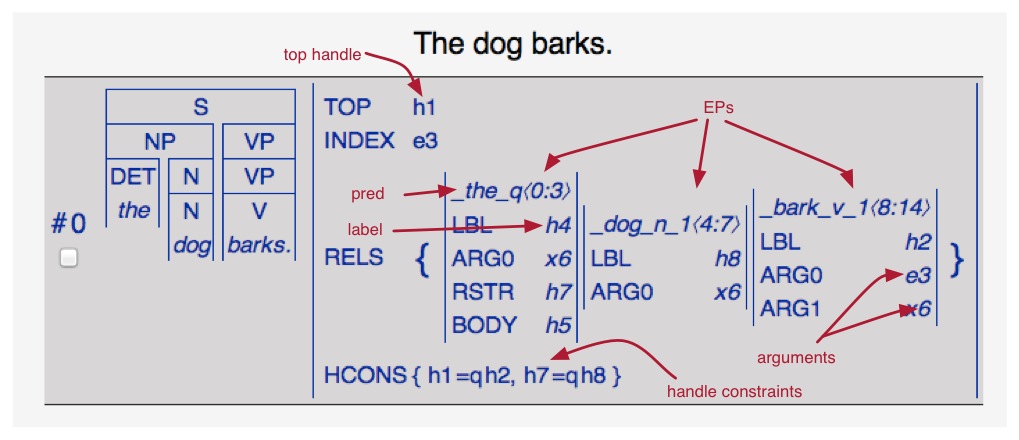-
Notifications
You must be signed in to change notification settings - Fork 4
DelphinTutorial_Formalisms
Strictly speaking, not a formalism but primarily a linguistic theory. See brief linguistic characterisation on the DelphinTutorial/Grammars page.
One of the early accomplishments of DELPH-IN partners was agreement on a joint reference formalism (i.e. a ‘designer logic’ for typed feature structures), blending elements of the formalisms proposed in Carpenter (1992), Copestake (1992), and Krieger & Schäfer (1994). The joint descriptive formalism can be informally characterized as a closed-world, conjunctive-only, multiple inheritance type system that enforces strong typing and strict appropriateness, but allows types to be associated with arbitrary (complex) constraints that are inherited and applied both at compilation and at run-time (e.g. when two types unify to a more specific, constraint-introducing subtype). HPSG well-formedness principles, immediate dominance schemata, and constituent ordering constraints are all spelled out in the type hierarchy (and cross-multiplied), yielding a set of phrase structure and lexical rules that can be interpreted as rewrite rules over complex (typed feature structure) categories by a suitable parser or generator.
MRS (Copestake et al 2005) is a system of semantic representations which is designed to support underspecification, notably of quantifier scope. Such underspecified representations can be taken as a description language for other kinds of semantic representations, e.g., predicate logic with generalized quantifiers.
The semantic information associated with an HPSG sign is called an MRS. While typically constructed through unification of typed feature structures (in parsing or generation), MRSs formally are not feature structures (or objects in the DELPH-IN Typed Feature Structure Logic; see below). An MRS consists of:
-
a distinguished label, called the top handle
-
a bag (i.e. unordered multi-set) of elementary predications (also called EPs)
-
and a bag of handle constraints
Each EP has a label (aka handle), a predicate symbol (or pred or relation) and a list of arguments. In many EPs (and in some grammars increasingly in all EPs), one of those arguments can be considered a distinguished variable (or characteristic variable). Depending on the type of the EP, this can be either an event variable or a referential index . The value of the other arguments may be either a handle or a variable. Handle-valued arguments are typically either the label of another EP or related via a handle constraint to the label of another EP. Variable-valued arguments are typically distinguished variables of other EPs within the same MRS.
The formatting conventions for predicate symbols allow them to encode lemma, part of speech, and additional coarse sense distinctions as well as distinguishing between lexical predicates (typically associated with particular lexical entries, where the lemmatized surface form occurs in the predicate symbol) and grammar predicates (or gpreds) introduced by grammatical rules or semantically decomposed lexical entries.
Note that DELPH-IN grammars typically do not make sense distinctions in MRS predicate symbols unless the sense distinction correlates with morphosyntactic differences between lexical entries.

While MRSs are the primary objects of meaning representation in DELPH-IN grammars, a number of variants have been defined throughout the years. Elementary Dependency Structures (EDS) reduce the bag of EPs and argument structure to a variable-free dependency graph. Robust Minimal Recursion Semantics (RMRS) further decomposes individual EPs (into sets of predications, one per argument in the original EP, linked together through a unique anchor assumed for each EP), to also allow underspecification of argument roles. Dependency MRS (DRMS) overlays the EDS graph with additional information about label (in)equalities among EPs, to allow interconversion between the original MRS and its variable-free form.
While MRS in the first instance is a formalism, the name can also be taken to refer to the collection of analyses that have been developed using this formalism, the vast majority of which are encoded in DELPH-IN grammars, especially the ERG. Documentation of these analyses is under way (see ErgSemantics), and the analyses are often the topic of discussion at DELPH-IN summits and smaller meetings.
Home | Forum | Discussions | Events